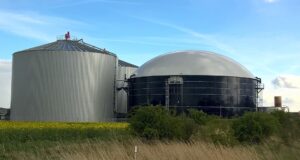Anaerobic digesters are used to process organic materials into biogas. They hold feedstock such as wastewater, food wastes, municipal solid wastes, animal manure, and crop residue for the anaerobic digestion (absence of oxygen).
There are various types of digesters for on-farm used, which vary in design, process, and capacity. These include covered lagoon digester, plug flow digester, complete mix digester, suspended media digester, and sequencing batch digester.

1. Covered Lagoon
A covered lagoon consists of one or more lagoons, an impermeable cover, a solids separator, and a biogas utilization system. It processes diluted manure with less than two percent solid. Other entities also utilized a cover lagoon for wastewater treatment.
The usual setup of a covered lagoon comprises two lagoons; the first is where the anaerobic digestion happens and a biogas recovery on top, while the second is an open-cell for effluent storage and odor control treatment.
The cover lagoon system only requires a small investment. However, it is weather-dependent and can only work in an optimum capacity in a warm climate of 37°C. Low biogas is extracted during cold climates and will need heating energy.
2. Plug Flow Digester
Plug flow is a rectangular, heated, insulated tank. It is primarily used in a dairy farm, which collects manure through scraping. Plug flow is consists of a mix tank, digester tank with heat exchanger and biogas recovery system, effluent storage structure, and biogas utilization system. Given its design, plug flow is usable in any climate but needs heating energy to keep the optimal heat level.
At least 15% of total solid content is needed for the digester to be effective. Its retention time is 15 to 20 days.
3. Complete Mix Digester
Complete mix digester is a tank with active microorganisms where manure is heated and mixed. An equal amount of liquid is displaced by the incoming liquid in the digester. Biogas is produced by adjusting the liquid volume for 20 to 30 days in the digester. The organic materials can be continually or intermittently stirred.
The digester is at an optimum with 3-6 percent of solids. A lower solid concentration means greater volume, which needs a larger digester to retain the anaerobic bacteria.
4. Suspended Media Digester
There are two common types of suspended media digester: Upflow Anaerobic Sludge Blanket (UASB) and the Induced Blanket Reactor (IBR). USAB is at optimum with low solid components, while IBR works best at high solid influents. Microbes are suspended in a constant liquid upward flow. It allows the smaller particles to wash out and retains the larger ones in the digester. Some of the effluents are recycled to provide a steady upward flow.
5. Sequencing Batch Digester
It is a variation of a mixed digester. The digester keeps the methanogens through settling solids and decanting liquid. Anaerobic sequencing batch reactor (ASBR) operates in four phases. Fill, react, settle, and decant phases.
The digester is fed on the fill phase. During the react phase, manure and microbes are mixed. The components then subside on the settle phase. Finally, effluent is washed out during the decant phase. For constant biogas production, the cycle is repeated up to four times. ASBR works best with very dilute manures.
Listed above are the five common types of on-farm digesters. Depending on the kind of livestock and process you execute on the farm, the kind of digester will vary. Knowing the different types of biogas anaerobic digesters will help you identify what’s suitable for your farm.

